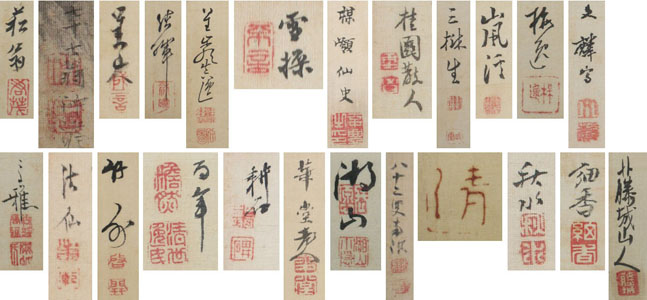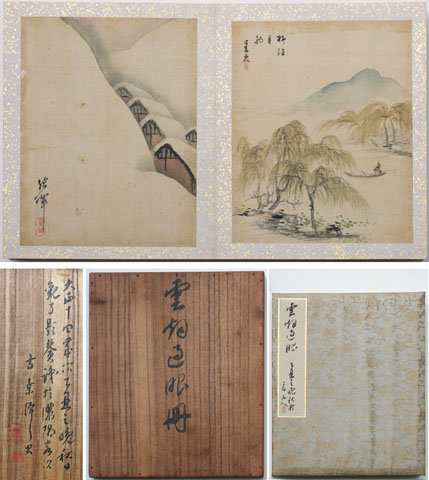Nanga Shijô
Un'en kangan tanzaku - Clouds of mist go pass the eye / 19 Miscalleneous subjects and 6 poemsSigned:
Seals:
Technique: colours on silk laid down on gold speckled paper c. 20 x 16 (23 x 18,8)
Box: Inscribed Taishô 14 1925
Condition: very good
1. Nukina Kaioku (1778-1863) 貫名海屋 - poem
[sign:] 菘翁「印」君茂、隠 Sûô {seal:] Kummo, Kakuhito (tp)
Kaioku (Sûô) became one of the most celebrated bunjin artists in Kyoto after the death of Rai San'yô (1780-1832). Along with Maki Ryoko (..) and Ichikawa Beian (..), he was one of the Bakumatsu no Sanpitsu, the three Brushes of the late Edo period).
Kaioku was born into a samurai family of hereditary archery instructors to the daimyo of the Hachisuka fief of Awa Province (now Tokushima Prefect. Although his father was a martial arts teacher Kaioku chose to be a Confucian scholar and for many years of his life he studied in several parts of Japan. After a brief training in Kanô painting he went to Nagasaki to study Nanga painting under the Zen-monk Hidaka Tetsuô (1791-1871). He studied calligraphy for three years by copying the style of the 9th century monk Kôbô Daishi. He finally settled in Kyoto where in 1828 he established Suseidô, his own school. Kaioku is considered one of the greatest calligraphers of the late Edo period.
2. Nakabayashi Chikutô (1776-1853) 中林竹洞 - Summer landscape (1852)
[sign:] 七十七翁沖澹「印」竹洞 nanajûnana ô (77) Chûtan [seal:] Chikutô
Chikutô is regarded as the theorist of the Nanga School and as such of great interest because he introduced the conservative nanga style into the 19th century Kansai area.
He was the son of a Nagoya doctor, but at the age of fifteen he became a protégé of Kamiya Ten'yû. At his house he saw and studied Chinese paintings. With his companion Yamamoto Baiitsu (1783-1856) they went to Kyoto in 1802 for a brief stay. In 1815 Chikutô went back to Nagoya permanently. He then joined the circle of Rai San'yô (1780-1832).
3. Hine Taizan (1813-1869) 日根對山 - Willow landscape with fisher
[sign:] 對山人 印」成言 Taizanjin [seal:] Seigen
Taizan considered himself an amateur scholar with a bunjin lifestyle, but he consistently acted the opposite by boasting and being drunk. He was born in Izumi, a village close to Osaka. In his early years he lived under the patronage of the wealthy shipping merchant Satoi Fukyû, who introduced Taizan to Okada Hankô (1782-1846) in 1842. Soon thereafter he was also introduced to Nukina Kaioku (1778-1863) in Kyoto, who became his teacher. When Taizan moved to Kyoto in 1846 he studied briefly with the Nagasaki painter-monk Hidaka Tetsuô (1791-1871), who visited Kyoto around that time.
Taizan was a popular artist among the Kansai aristocracy and he had many patrons and friends like Yanagawa Seigan (1789-1858), Nakabayashi Chikkei (1816-67) and Tesseki (1817-63).
4. Yokoyama Seiki (1792-1864) 横山清暉 - Houses in the snow
[sign:] 清暉 「印」清暉 Seiki [seal:] Seiki
Seiki is considered to have been the best pupil of Matsumura Keibun (1780-1844), His landscapes though show much influence of Okamura Toyohiko's (1773-1845). The best of both assembled in one.
5. Yanagawa Seigan (1781-1858) 梁川星巖 - poem
sign: 星巌真☐「印」涂絲, 公圖、☐心 Seigan shin .. [seals:] Toshi, Kôto, ..shin (tp)
Seigan was one of those interesting Confucians in late Edo Japan criticizing the Tokugawa government. After the death of Rai San’yô (1780-1832) he and his wife Kôran moved to Edo where they became involved in Western learning and anti Tokugawa activities. Two days before his arrest he died of cholera. His wife was arrested and imprisoned for five months after burning her husband’s incriminating correspondence and for refusing to mention the names of loyalists. The Bakufu hunted down most of their friends, Ikkei being one of them. Many didn’t survive imprisonment and punishment.
6. Kaneko Sessô (1794-1857) - Landscape (1856)
[sign:] 雪操「印」不言 Sessô [seal:] Fugen
Sessô was born in Edo, into samurai family. He was adopted by the Kneko family. He studied painting with Masuyama Sessai (1755-1820), lord of Ise. Later he studied Nanga painting under Kushiro Unsen (1759-1811).
7. Kôno Bairei (1844-1895) 幸野楳嶺 - Fisher in the rain
[sign:] 楳嶺仙史「印」 幸豊之印 Bairei Senshi [seal:] Kô Toyo noin
Bairei was one of the most important painters in Kyôto during the Meiji period.
At the age of eight Bairei started as a pupil in the Maruyama studio of Nakajima Raishô; after Raishô he went to Bunrin to study the Shijô style. Trying to become an even more complete artist he also studied the Nanga style with Nakanishi Kôseki (1807-1884) and Maeda Chôdô (1817-1878). Bairei, Kubota Beisen (1852-1906) and Tanomura Chokunyû (1814-1907) established the Kyôto Prefectural School of Painting in 1880. Together with Suzuki Hyakunen (1825-1891) he became the head of the Kanô section. Perhaps Bairei's importance lies primarily in the fact that he was an inspired teacher. He taught some of the most talented painters active in the first decades of the 20th century.
8. Hashimoto Keien (1811-1880) 橋本桂園 - Landscape (1857)
[sign:] 桂園敬人 「印」☐☐ Keien keijin [seal:] unread
Keien was born in Osaka. He studied with Okada Hankô (1782-1846)
9. Rai Ôgai (1824-1859) 頼鴨崖 - Poem
[sign:] 三樹生「印」☐☐、☐☐、古狂 Sanjusei [seal:] .. .., .. .., Kokyô (tp)
Poet. Sanjusanrô (Rai Ôgai) was the 3rd son of Rai San’yô (1780-1832)
10. Hasegawa Rankei (1813-1865) 長谷川嵐渓 - Landscape
[sign:] Rankei 嵐渓「印」張☐之印 Rankei [seals:] Chô .. noin
Rankei was born in Echigo Province but went as youth to Edo. Here he studied with Haruki Nanko (1759-1839), moved to Sendai where he studied with Tôdsai Baikan.
11. Yamamoto Baiitsu (1783-1856) 山本梅逸 - Pomgranate (1852)
[sign:] 梅逸「印」梅逸 Baiitsu [seal:] Baiitsu
Baiitsu was born in Nagoya, son of a sculptor in the service of the Owari clan. Baiitsu studied painting with the Shijō painter Chō Gesshō (1772-1832) and he became a protégé of Kamiya Ten'yū (1721-1801), a wealthy collector of Chinese paintings in Nagoya. Together with Chikutō, another uchi deshi (resident pupil) they learned Chinese painting styles.
After the death of Ten’yū in 1802, both Chikutō and Baiitsu traveled to Kyoto. In 1803 Baiitsu traveled Japan (using Nagoya as his base). In 1814 he spent considerable time in Edo with Bunchō. Baiitsu as well as Chikutō were acquainted with many of their fellow bunjin like Shunkin, Chikuden and Okada Hankō (1782-1846). Baiitsu taught many pupils and together with Chikutō they were considered two best Nanga painters working in Nagoya. Baiitsu finally returned in 1854 to retire under the patronage of the Owari clan.
12. Shiokawa Bunrin (1801-1877) 塩川文麟 - Village in the rain
[sign:] 文麟写「印j」文麟写 Bunrin sha [seal:] Bunrin
If any one artist created Nihonga it would have to be Bunrin. He explored the boundaries of the Maruyama-Shijô style and searched for new interpretations in the Nanga style. On top of that he experimented with new painting methods. Through Kôno Bairei (1844-95), his major pupil, his influence reached well into the twentieth century.
Bunrin’s father was in the service of the Takatsukase family. When in 1820 both his parents died he was sent to Kyoto to study painting. Soon thereafter the head of the Takatsukase family recognized his talent and arranged a place in Toyohiko’s studio (together with a lifetime allowance of rice). He received his training in the Maruyama -Shijô style, but at least as important was his access to Toyohiko’s ‘mythical’ box of copies.
13. Unread (Tosa school) - Courtling
[sign:] ☐雅「印」 雅印、☐☐氏 [seals:]
14. Oda Kaisen (1785-1862) 小田海僊 - Landscape
[sign:] 海仙「印」王嬴之印、巨海 Kaisen [seals:] Ôei noin, Kyokai
Kaisen was born in Yamaguchi, but was adopted by a family of dyers in Shimonoseki. He moved to Kyoto when he was 22 and became a pupil of Go Shun (1752-1811), but he also came under the influence of San'yô with whom he traveled to Nagasaki, where he studied Chinese painting for five years. On his return Kaisen joined a group with Chikuden and Uragami Gyokudô (1745-1820). Kaisen created his own style, neither Maruyama-Shijô, nor Nanga, but the townspeople in Kyoto loved it.
15. Fujii Chikugai (1807-1866) 藤井竹外 - Poem
[sign:] 竹外「印」 啓開 Chikugai [seals:] Kei Kai
Poet. Student of Rai San’yô (1780-1832)
16. Suzuki Hyakunen (1825-1891) 鈴木百年 - Peaches (1870)
[sign:] 百年「印」澹然、清世逸民 Hyakunen [seals:] Tannen, Seise itsumin
Suzuki Tosho, a pioneer Japanese astronomer, was the father of Hyakunen. He lived in Kyôto. Hyakunen studied first with Yokoyama Kakei (1816-1864), then indepently various Chinese and Japanese styles. He was influenced by Onishi Chinnen (1792-1851). For a while he taught at the Kyôto Prefectural School of Painting. Received awards at the 1st and 2nd exhibitions of the Naikoku Kaiga Kyôshinkai. Specialized in landscape following the traditions of the Shijô school, though toward the end of his life turned to Nanga
17. Nakanishi Kôseki (1807-1884) 中西耕石- Li Po
[sign:] 耕石「印」中西壽、耕石 Kôseki [seals:] Nakanishi Hisashi, Kôseki
Kôseki was born in Ashiya, the son of a potter. In Osaka he studied calligraphy with Shinozaki Shôchiku (1781-1851), and in Kyoto painting with Oda Kaisen (1785-1862). Later he founded his own school.
He was a very popular painter in Kansai and considered as famous as Hine Taizan (1813-1869) and Maeda Chôdô (1817-1878).
A representative in the transition to the Meiji Nanga style.
18. Kita Kadô (1812-1877) 喜田華堂 - rock (1862)
[sign:] 華堂老人「印」華堂 Kadô rôjin [seal:]華堂
Kadô was born in Gifu Pref. In Kyoto he became a pupil of Gan Ku (1749-1838) and later of his son Gan Tai (1782-1865) and Gan ryô (1798-1852). He moved to Nagoya where he continued the Kishi school.
19. Ono Kozan (1804-1900) 小野湖山 - poem
[sign:] 湖山「印」長愿、湖山小☐ Kozan [seals:] Chôgen, Kozan O..
A celebrated poet of the Meiji era. Student of Yanagawa Seigan (1781-1858)
20. Haruki Nammei (1795-1878) 春木南溟 - Waterfall landcspe (1876)
[sign:] 八十二叟南溟 Hachijûni shû (82) Nammei [seals:] illegable
Nanmei was the son and pupil of Nanko (1759-1839). He studied with his father as well as with Tani Bunchô (1763-1840).
Already at a young age Nammei’s work can be found on the many gassaku, collaborative works that were produced in Edo in the 1810s and 1820s together with the artists from his father’s generation. Being acquainted with these artists also made him an important artist in the Edo art circles. His paintings ultimately surpassed his father’s both technically as decoratively.
Nanmei was an eclectic painter and in due course he became more appreciated in Japan than his assertive father. He did well and managed to find himself a number of patrons in the bakufu.
21. Watanabe Kiyoshi (1778-1861) 渡辺清 - Bracken
[seal:] 清 Kiyoshi
Kiyoshi was born in Nagoya. He went to Kyoto to study with Yoshikawa Hidenobu, Tosa Mitsusada (1738-1806) and Tanaka Totsugen (1760-1823), so moving from Kanô, through Tosa to Yamato-e. He also studied Japanology with Motoori Norinaga (1730-1801) and Uematsu Arinobu and Sinology with Shin Ken and became an expert on ancient Japanese customs and manners. A delicate painter with a rather individual style.
22. Murase Shûsui (1795-1876) 村瀬秋水 - Landscape
[sign/seal:] 秋水 「印」秋水 Shûsui
Studied with Chô Gesshô (1772-1832) and later with Noro Kaiseki (1747-1828). He went to Nagasaki to become a pupil of Hidaka Tetsuô (1791-1871). He was the author of many books.
23. Ema Saikô (1787-1861) 江馬細香 - Bamboo
[sign/seal:] 細香 Saikô
Saikô was the daughter of a doctor of medicine, and anavid scholar of both Confucianism and Rangaku. She was taufght calligraphy and painting by her father, with whom she had strong bond after the death of her mother. She studied with Gyokurin (1751-1814), a monk who was specialized in bamboo painting.
In 1813 Saikô and Rai San’yô (1780-1832) met. They did not marry but had a close relationship for years. Through San’yô she was well acqainted with the Kyoto bunjin.
24. Murase Tôjô (1790-1853) 村瀬藤域 - Poem (1851 Kaiei 4)
{sign:} 藤域山人「印」藤域 Tôjô sanjin [seal:] Tôjô
Poet. Student of Rai San’yô (1780-1832)
Price: SOLD

